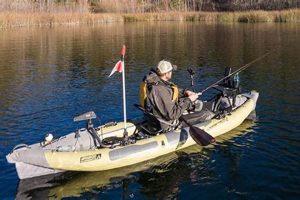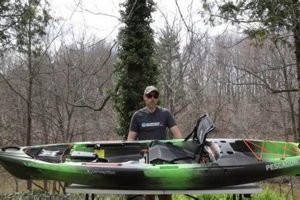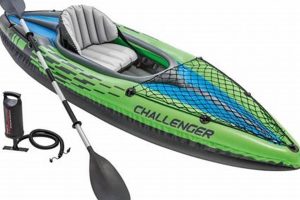A top-tier beginner’s fishing kayak represents a balanced combination of affordability, stability, and essential features. Such a vessel typically provides ample storage for fishing gear, comfortable seating for extended trips, and a stable platform for casting and reeling. An example might include a sit-on-top model with built-in rod holders, a spacious tank well, and a paddle holder.
Choosing an appropriate watercraft for novice anglers is critical for a positive introduction to the sport. A stable and well-equipped platform fosters confidence on the water, allowing newcomers to focus on developing their fishing techniques rather than battling instability or inadequate equipment. Over the past few decades, the evolution of kayak design and manufacturing has led to a wider selection of specialized fishing kayaks that cater to diverse skill levels and budgets, making the pursuit accessible to a broader audience.
The following sections will delve into key considerations for selecting an optimal introductory fishing kayak, including hull design, features, materials, and budget, ultimately equipping readers to make informed purchasing decisions. Topics will range from analyzing stability and maneuverability to understanding the trade-offs between various materials and feature sets.
Tips for Selecting an Optimal Beginner Fishing Kayak
Choosing a suitable vessel for novice anglers involves careful consideration of several factors. The following tips offer guidance for selecting an ideal introductory fishing kayak.
Tip 1: Prioritize Stability: Wider, flatter hulls offer greater stability, particularly important for newcomers. Consider a sit-on-top design for enhanced initial stability.
Tip 2: Evaluate Maneuverability: Shorter kayaks are generally more maneuverable, allowing for easier navigation in tighter spaces like creeks and rivers. Longer kayaks offer better tracking in open water.
Tip 3: Consider Weight Capacity: Ensure the kayak’s weight capacity accommodates the angler’s weight, plus gear and potential catches.
Tip 4: Assess Storage Options: Ample storage is crucial for fishing gear. Look for dedicated compartments, tank wells, and bungee cords.
Tip 5: Check Seating Comfort: A comfortable seat is essential for longer trips. Adjustable seating and back support are desirable features.
Tip 6: Consider Rod Holders: Built-in rod holders allow hands-free paddling and easier fishing.
Tip 7: Research Materials and Durability: High-density polyethylene (HDPE) offers a robust and budget-friendly option. Consider higher-end materials like fiberglass or composites for enhanced performance and durability.
By considering these factors, anglers can choose a suitable vessel that balances stability, maneuverability, comfort, and practicality, leading to a more enjoyable fishing experience.
The information presented here serves as a foundation for informed decision-making when selecting a first fishing kayak. The next section will provide an overview of recommended models based on the criteria discussed.
1. Stability
Stability stands as a cornerstone for an enjoyable and safe kayaking experience, especially for beginners. In the context of selecting an optimal entry-level fishing kayak, stability directly influences an angler’s ability to cast, reel, and land fish effectively, while also mitigating the risk of capsizing. A stable platform fosters confidence and allows novices to focus on developing fishing skills rather than managing precarious balance.
- Hull Design and Stability
Hull design significantly impacts stability. Wider, flatter hulls generally offer greater primary stability (initial resistance to tipping), making them suitable for calmer waters and beginners. Conversely, narrower, V-shaped hulls provide better secondary stability (resistance to tipping once tilted) and are more efficient for paddling in open water but require more experience to manage. A wider, flatter hull design is frequently recommended for entry-level fishing kayaks due to the enhanced initial stability.
- Center of Gravity and Stability
A lower center of gravity contributes to greater stability. Sit-on-top kayaks inherently have a lower center of gravity compared to sit-inside kayaks, providing a more stable platform. Additionally, the distribution of weight within the kayak influences stability. Keeping heavier items lower and centered enhances overall stability. Understanding weight distribution is crucial for maintaining balance, particularly when casting or reeling in fish.
- Water Conditions and Stability
Water conditions play a crucial role in perceived stability. Calm lakes and ponds offer a more stable environment compared to rivers or coastal areas with currents and waves. Wind can also significantly impact stability. Choosing an appropriate kayak and understanding the limitations based on prevailing water and weather conditions is paramount for safety and a positive experience.
- Personal Factors and Stability
Individual factors such as body weight, height, and experience level influence how stable a kayak feels. Beginners may feel more comfortable in wider, more stable kayaks, even in calmer conditions. As experience grows, anglers may transition to kayaks with different stability characteristics to suit specific fishing styles and environments.
Ultimately, prioritizing stability in the selection of an entry-level fishing kayak promotes a safe and enjoyable introduction to the sport. Understanding the interplay between hull design, center of gravity, water conditions, and personal factors empowers novice anglers to choose a kayak that instills confidence and allows them to focus on honing their fishing skills.
2. Maneuverability
Maneuverability represents a crucial factor in evaluating the suitability of a kayak for fishing, particularly for beginners. Efficient navigation through diverse water environments, from narrow creeks to open lakes, directly impacts an angler’s ability to reach desired fishing spots and effectively present lures or bait. Understanding the factors that influence maneuverability is essential for selecting an optimal entry-level fishing kayak.
- Hull Length and Shape
Shorter kayaks generally offer greater maneuverability, allowing for tighter turns and easier navigation in confined spaces. Longer kayaks, while offering better tracking in open water, require more effort to turn and maneuver. For beginners fishing in varied or confined waterways, a shorter hull length often proves advantageous. For instance, a kayak under 12 feet might be ideal for navigating small rivers or ponds, while a longer kayak would be better suited for larger lakes or open water.
- Width and Hull Design
Wider kayaks tend to be less maneuverable than narrower kayaks. However, width contributes to stability, a critical factor for beginners. The hull design also plays a role; a flatter hull enhances maneuverability in shallow water, while a more rounded or V-shaped hull improves tracking but may sacrifice some turning ability. Balancing stability and maneuverability is key when selecting an entry-level kayak.
- Water Conditions
Currents, wind, and waves can significantly impact maneuverability. A kayak that handles well in calm water might become challenging to control in windy conditions or strong currents. Beginners should consider the typical water conditions they will encounter and choose a kayak that offers adequate maneuverability in those environments. For example, a kayak with a skeg or rudder can improve tracking and control in windy or choppy conditions.
- Weight and Payload
The total weight of the kayak, including the angler, gear, and any potential catch, affects maneuverability. A heavier kayak will require more effort to turn and maneuver. Choosing a lighter kayak within the appropriate weight capacity range can improve overall maneuverability. This is especially relevant for beginners who may not have the strength or experience to easily manage a heavier, fully loaded kayak.
Considering these factors in conjunction with other essential features, such as stability and storage capacity, enables novice anglers to select an entry-level fishing kayak that balances performance and practicality. The right balance of maneuverability contributes significantly to a positive and productive fishing experience, allowing beginners to focus on developing their angling skills rather than struggling with controlling their vessel.
3. Storage Capacity
Adequate storage capacity is a critical factor when selecting a best entry-level fishing kayak. The ability to transport essential gear, including tackle boxes, rods, safety equipment, and personal items, directly impacts the practicality and enjoyment of fishing excursions. Insufficient storage can lead to a cluttered cockpit, hindering movement and casting, while ample and well-organized storage contributes to a more efficient and comfortable fishing experience.
- Types of Storage
Fishing kayaks offer various storage solutions, including dedicated compartments, tank wells, and bungee cord systems. Dedicated compartments provide secure storage for smaller items like tackle boxes and tools, protecting them from water and damage. Tank wells, typically located at the bow or stern, offer open storage for larger items like crates or coolers. Bungee cords secure items on deck for quick access. Understanding the types and availability of storage options is crucial for selecting a kayak that meets individual needs.
- Storage Capacity and Kayak Size
Storage capacity often correlates with kayak size. Longer kayaks generally offer more storage space than shorter models. However, larger kayaks can be heavier and less maneuverable. Balancing storage needs with desired kayak size and maneuverability is essential. A shorter kayak with strategically placed storage compartments can offer a good compromise for anglers prioritizing agility.
- Weight Capacity and Storage
The kayak’s weight capacity dictates the total weight it can safely carry, including the angler, gear, and any potential catch. Overloading a kayak compromises stability and safety. Calculating the total weight of anticipated gear and selecting a kayak with sufficient weight capacity is crucial. It’s essential to factor in not only the volume of gear but also its weight when considering storage capacity.
- Accessibility and Organization
Easy access to stored gear is vital for efficient fishing. Well-placed hatches, readily accessible tank wells, and strategically positioned bungee cords facilitate quick retrieval of necessary items. Features that promote organization, such as dividers within compartments, enhance efficiency and prevent clutter. Evaluating the accessibility and organization features of a kayak contributes to a more streamlined and enjoyable fishing experience.
Ultimately, the appropriate storage capacity in an entry-level fishing kayak contributes significantly to functionality and overall fishing enjoyment. Carefully considering the types of storage, kayak size, weight capacity, and accessibility allows novice anglers to select a vessel that effectively balances storage needs with other essential performance characteristics. A well-equipped kayak provides a comfortable and organized platform, allowing anglers to focus on the sport rather than managing gear.
4. Comfort Features
Comfort features play a significant role in the overall enjoyment and effectiveness of a fishing kayak, especially for beginners. Extended periods on the water require a comfortable and supportive environment to minimize fatigue and maximize focus on fishing. A well-designed, comfortable kayak allows anglers to concentrate on the sport rather than discomfort, leading to a more positive and productive experience. Selecting a kayak with appropriate comfort features is crucial, particularly for extended fishing trips.
- Seat Design and Adjustability
Seat design significantly impacts comfort. Look for adjustable seating systems that allow for customization of back support, height, and legroom. A comfortable, supportive seat promotes proper posture and reduces strain during long hours on the water. Features like padded seating and breathable fabrics enhance comfort and prevent discomfort caused by moisture and heat. An adjustable seat allows anglers to fine-tune their position for optimal comfort and fishing effectiveness.
- Footrests and Leg Support
Adjustable footrests or foot braces provide essential leg support and contribute to stability and paddling efficiency. Proper leg support reduces fatigue and allows for a more powerful and comfortable paddling stroke. Adjustable footrests accommodate different leg lengths and paddling styles. Secure and comfortable foot placement enhances overall control and balance within the kayak.
- Deck Padding and Cockpit Design
Adequate deck padding provides cushioning and traction, enhancing comfort and stability when standing or moving around the kayak. A well-designed cockpit with sufficient legroom and easy access to hatches and storage compartments further improves comfort and functionality. Features like recessed rod holders and cup holders contribute to a more organized and convenient cockpit environment.
- Backrests and Lumbar Support
Proper back support is crucial for comfort during long fishing trips. Look for kayaks with adjustable backrests that provide adequate lumbar support. A supportive backrest helps maintain proper posture and reduces strain on the back, especially during extended periods of sitting. Features like breathable mesh backrests enhance comfort and airflow, reducing heat and moisture buildup.
In the context of selecting the best entry-level fishing kayak, prioritizing comfort features contributes significantly to a positive and productive fishing experience. A comfortable and supportive kayak allows novice anglers to focus on developing their skills and enjoying the sport without being hindered by discomfort or fatigue. Investing in a kayak with well-designed comfort features ultimately enhances the overall fishing experience and encourages continued participation in the sport.
5. Affordable Price
Affordability represents a critical factor for individuals entering the sport of kayak fishing. The initial investment in a kayak, along with necessary accessories, can be substantial. A “best entry-level fishing kayak” balances performance, features, and cost-effectiveness, making the sport accessible to a wider audience. Understanding the nuances of affordability within this context requires exploring various influencing factors.
- Initial Investment vs. Long-Term Value
While the initial price tag is a significant consideration, evaluating long-term value is crucial. A slightly more expensive kayak constructed from durable materials might offer better longevity and require less maintenance compared to a cheaper model prone to damage. Considering potential repair or replacement costs over time contributes to a more comprehensive understanding of affordability. For example, a kayak made from high-density polyethylene (HDPE) might have a higher upfront cost but offer superior durability compared to a less expensive model made from lower-grade plastic.
- Features and Price Point
Entry-level kayaks often come with fewer features than high-end models. Determining essential features versus desirable but non-essential features helps manage costs. Prioritizing necessary features like stability, storage, and comfortable seating over advanced features like integrated fish finders or pedal drives can lead to significant cost savings. An angler prioritizing basic functionality might choose a kayak with molded-in rod holders and a basic seat over one with adjustable rod holders and a premium seat.
- Material Selection and Cost
Kayak construction materials directly impact price. High-density polyethylene (HDPE) offers a durable and affordable option, while higher-end materials like fiberglass or composites come at a premium. Understanding the performance characteristics and durability trade-offs associated with different materials helps determine the most cost-effective option for individual needs. A beginner angler might opt for a durable HDPE kayak over a lighter, more expensive fiberglass model for their initial foray into the sport.
- Accessories and Additional Costs
The cost of essential accessories, such as paddles, life vests, and fishing gear, should be factored into the overall budget. Researching and comparing prices for these necessary additions provides a more realistic picture of the total investment required. Considering package deals that include essential accessories can sometimes offer cost savings compared to purchasing items individually. For example, some retailers offer packages that include a kayak, paddle, and personal flotation device (PFD) at a discounted price.
Ultimately, defining “affordable price” in the context of a “best entry-level fishing kayak” requires careful consideration of initial investment, long-term value, features, materials, and additional costs. By prioritizing essential features and materials while considering long-term durability, novice anglers can identify a kayak that offers optimal performance and value within their budget constraints. This balanced approach ensures accessibility to the sport without compromising quality or safety.
Frequently Asked Questions
This section addresses common inquiries regarding the selection and use of entry-level fishing kayaks.
Question 1: What is the typical price range for a suitable entry-level fishing kayak?
Prices typically range from $500 to $1,500, depending on features, materials, and brand. Significant cost savings can be achieved by considering used kayaks, though careful inspection is recommended.
Question 2: Which hull design is recommended for beginners sit-on-top or sit-inside?
Sit-on-top kayaks are generally recommended for beginners due to their inherent stability and ease of entry and exit. They are also self-bailing, an important safety feature.
Question 3: What essential features should one look for in an entry-level fishing kayak?
Essential features include rod holders, storage compartments, a comfortable seat, and sufficient stability. Adjustable footrests and a paddle holder are also desirable features.
Question 4: What are the key differences between high-density polyethylene (HDPE) and fiberglass kayaks?
HDPE kayaks offer durability and affordability, while fiberglass kayaks are lighter and offer better performance but come at a higher price point. HDPE is generally recommended for beginners due to its robustness.
Question 5: How important is weight capacity when choosing a fishing kayak?
Weight capacity is crucial. The kayak must accommodate the angler’s weight plus the weight of all gear and potential catches. Exceeding the weight capacity compromises stability and safety.
Question 6: What safety precautions should be taken when using a fishing kayak?
Always wear a personal flotation device (PFD). Inform someone of your fishing plans, including location and expected return time. Check weather conditions before embarking and be aware of potential hazards such as currents and boat traffic.
Careful consideration of these frequently asked questions empowers individuals to make informed decisions when selecting and utilizing an entry-level fishing kayak. Prioritizing safety and understanding key features contributes significantly to a positive and productive fishing experience.
The subsequent sections will provide in-depth reviews and comparisons of several recommended entry-level fishing kayak models, assisting readers in making an optimal purchase decision.
Conclusion
Optimal introductory fishing kayaks represent a carefully considered balance of affordability, stability, and essential features. Selecting such a vessel requires evaluating hull design, maneuverability, storage capacity, comfort features, and overall cost. Prioritizing stability ensures a confident and safe experience for novice anglers, while adequate storage and comfortable seating contribute to longer, more enjoyable outings. Understanding the trade-offs between materials like high-density polyethylene and fiberglass allows for informed decision-making based on individual needs and budget constraints.
The pursuit of angling from a kayak offers a unique connection with nature and a rewarding challenge. Choosing the appropriate entry-level vessel lays the foundation for a successful and enriching experience on the water. Careful consideration of the factors presented herein empowers individuals to embark on this journey equipped with the knowledge to make informed decisions, fostering a lifelong appreciation for the sport.






